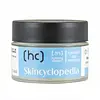What's inside
What's inside
 Key Ingredients
Key Ingredients

 Benefits
Benefits

 Concerns
Concerns

 Ingredients Side-by-side
Ingredients Side-by-side

Water
Skin ConditioningCaprylic/Capric Triglyceride
MaskingCetearyl Alcohol
EmollientGlycerin
HumectantCeteareth-20
CleansingDimethicone
EmollientPEG-8
HumectantPEG-8/Smdi Copolymer
Palmitoyl Myristyl Serinate
Skin ConditioningSodium Polyacrylate
AbsorbentButylene Glycol
HumectantOryza Sativa Bran Extract
Skin ConditioningXanthan Gum
EmulsifyingTriethanolamine
BufferingSodium Hyaluronate
HumectantPhenoxyethanol
PreservativeAcrylates/C10-30 Alkyl Acrylate Crosspolymer
Emulsion StabilisingDisodium EDTA
Water, Caprylic/Capric Triglyceride, Cetearyl Alcohol, Glycerin, Ceteareth-20, Dimethicone, PEG-8, PEG-8/Smdi Copolymer, Palmitoyl Myristyl Serinate, Sodium Polyacrylate, Butylene Glycol, Oryza Sativa Bran Extract, Xanthan Gum, Triethanolamine, Sodium Hyaluronate, Phenoxyethanol, Acrylates/C10-30 Alkyl Acrylate Crosspolymer, Disodium EDTA
Water
Skin ConditioningGlycerin
HumectantGlyceryl Stearate
EmollientCetearyl Alcohol
EmollientCoco-Caprylate/Caprate
EmollientNiacinamide
SmoothingArgania Spinosa Kernel Oil
EmollientEthylhexyl Stearate
EmollientButyrospermum Parkii Butter
Skin ConditioningSodium Hyaluronate
HumectantCeramide NP
Skin ConditioningCeramide AP
Skin ConditioningCeramide EOP
Skin ConditioningPhytosphingosine
Skin ConditioningTocopheryl Acetate
AntioxidantCetyl Palmitate
EmollientCeteareth-20
CleansingCeteareth-12
EmulsifyingPhenoxyethanol
PreservativeEthylhexylglycerin
Skin ConditioningCholesterol
EmollientSodium Lauroyl Lactylate
EmulsifyingCarbomer
Emulsion StabilisingXanthan Gum
EmulsifyingWater, Glycerin, Glyceryl Stearate, Cetearyl Alcohol, Coco-Caprylate/Caprate, Niacinamide, Argania Spinosa Kernel Oil, Ethylhexyl Stearate, Butyrospermum Parkii Butter, Sodium Hyaluronate, Ceramide NP, Ceramide AP, Ceramide EOP, Phytosphingosine, Tocopheryl Acetate, Cetyl Palmitate, Ceteareth-20, Ceteareth-12, Phenoxyethanol, Ethylhexylglycerin, Cholesterol, Sodium Lauroyl Lactylate, Carbomer, Xanthan Gum
 Reviews
Reviews

Ingredients Explained
These ingredients are found in both products.
Ingredients higher up in an ingredient list are typically present in a larger amount.
Ceteareth-20 is an emulsifier and cleansing agent. It is derived from cetearyl alcohol, a fatty alcohol.
As an emulsifier, Ceteareth-20 prevents oil and water from separating. It is also a surfactant. Surfactants help gather oil, pollution, and dirt to be washed away.
Cetearyl alcohol is a mixture of two fatty alcohols: cetyl alcohol and stearyl alcohol. It is mainly used as an emulsifier. Emulsifiers help prevent the separation of oils and products. Due to its composition, it can also be used to thicken a product or help create foam.
Cetearyl alcohol is an emollient. Emollients help soothe and hydrate the skin by trapping moisture.
Studies show Cetearyl alcohol is non-toxic and non-irritating. The FDA allows products labeled "alcohol-free" to have fatty alcohols.
This ingredient is usually derived from plant oils such as palm, vegetable, or coconut oils. There is debate on whether this ingredient will cause acne.
Due to the fatty acid base, this ingredient may not be Malassezia folliculitis safe.
Learn more about Cetearyl AlcoholGlycerin is already naturally found in your skin. It helps moisturize and protect your skin.
A study from 2016 found glycerin to be more effective as a humectant than AHAs and hyaluronic acid.
As a humectant, it helps the skin stay hydrated by pulling moisture to your skin. The low molecular weight of glycerin allows it to pull moisture into the deeper layers of your skin.
Hydrated skin improves your skin barrier; Your skin barrier helps protect against irritants and bacteria.
Glycerin has also been found to have antimicrobial and antiviral properties. Due to these properties, glycerin is often used in wound and burn treatments.
In cosmetics, glycerin is usually derived from plants such as soybean or palm. However, it can also be sourced from animals, such as tallow or animal fat.
This ingredient is organic, colorless, odorless, and non-toxic.
Glycerin is the name for this ingredient in American English. British English uses Glycerol/Glycerine.
Learn more about GlycerinPhenoxyethanol is a preservative that has germicide, antimicrobial, and aromatic properties. Studies show that phenoxyethanol can prevent microbial growth. By itself, it has a scent that is similar to that of a rose.
It's often used in formulations along with Caprylyl Glycol to preserve the shelf life of products.
Sodium Hyaluronate is hyaluronic acid's salt form. It is commonly derived from the sodium salt of hyaluronic acid.
Like hyaluronic acid, it is great at holding water and acts as a humectant. This makes it a great skin hydrating ingredient.
Sodium Hyaluronate is naturally occurring in our bodies and is mostly found in eye fluid and joints.
These are some other common types of Hyaluronic Acid:
Learn more about Sodium HyaluronateWater. It's the most common cosmetic ingredient of all. You'll usually see it at the top of ingredient lists, meaning that it makes up the largest part of the product.
So why is it so popular? Water most often acts as a solvent - this means that it helps dissolve other ingredients into the formulation.
You'll also recognize water as that liquid we all need to stay alive. If you see this, drink a glass of water. Stay hydrated!
Learn more about WaterXanthan gum is used as a stabilizer and thickener within cosmetic products. It helps give products a sticky, thick feeling - preventing them from being too runny.
On the technical side of things, xanthan gum is a polysaccharide - a combination consisting of multiple sugar molecules bonded together.
Xanthan gum is a pretty common and great ingredient. It is a natural, non-toxic, non-irritating ingredient that is also commonly used in food products.
Learn more about Xanthan Gum